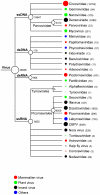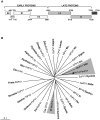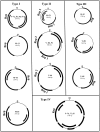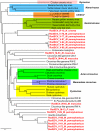The fecal viral flora of wild rodents
- PMID: 21909269
- PMCID: PMC3164639
- DOI: 10.1371/journal.ppat.1002218
The fecal viral flora of wild rodents
Abstract
The frequent interactions of rodents with humans make them a common source of zoonotic infections. To obtain an initial unbiased measure of the viral diversity in the enteric tract of wild rodents we sequenced partially purified, randomly amplified viral RNA and DNA in the feces of 105 wild rodents (mouse, vole, and rat) collected in California and Virginia. We identified in decreasing frequency sequences related to the mammalian viruses families Circoviridae, Picobirnaviridae, Picornaviridae, Astroviridae, Parvoviridae, Papillomaviridae, Adenoviridae, and Coronaviridae. Seventeen small circular DNA genomes containing one or two replicase genes distantly related to the Circoviridae representing several potentially new viral families were characterized. In the Picornaviridae family two new candidate genera as well as a close genetic relative of the human pathogen Aichi virus were characterized. Fragments of the first mouse sapelovirus and picobirnaviruses were identified and the first murine astrovirus genome was characterized. A mouse papillomavirus genome and fragments of a novel adenovirus and adenovirus-associated virus were also sequenced. The next largest fraction of the rodent fecal virome was related to insect viruses of the Densoviridae, Iridoviridae, Polydnaviridae, Dicistroviriade, Bromoviridae, and Virgaviridae families followed by plant virus-related sequences in the Nanoviridae, Geminiviridae, Phycodnaviridae, Secoviridae, Partitiviridae, Tymoviridae, Alphaflexiviridae, and Tombusviridae families reflecting the largely insect and plant rodent diet. Phylogenetic analyses of full and partial viral genomes therefore revealed many previously unreported viral species, genera, and families. The close genetic similarities noted between some rodent and human viruses might reflect past zoonoses. This study increases our understanding of the viral diversity in wild rodents and highlights the large number of still uncharacterized viruses in mammals.
Conflict of interest statement
The authors have declared that no competing interests exist.
Figures








References
-
- Huchon D, Madsen O, Sibbald MJ, Ament K, Stanhope MJ, et al. Rodent phylogeny and a timescale for the evolution of Glires: evidence from an extensive taxon sampling using three nuclear genes. Mol Biol Evol. 2002;19:1053–1065. - PubMed
-
- Meerburg BG, Singleton GR, Kijlstra A. Rodent-borne diseases and their risks for public health. Crit Rev Microbiol. 2009;35:221–270. - PubMed
-
- Charrel RN, de Lamballerie X. Zoonotic aspects of arenavirus infections. Vet Microbiol. 2010;140:213–220. - PubMed
-
- Klein SL, Calisher CH. Emergence and persistence of hantaviruses. Curr Top Microbiol Immunol. 2007;315:217–252. - PubMed
Publication types
MeSH terms
Grants and funding
LinkOut - more resources
Full Text Sources
Other Literature Sources
Medical
Miscellaneous

